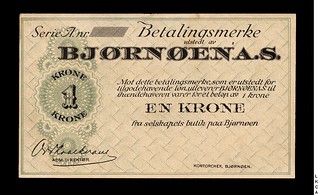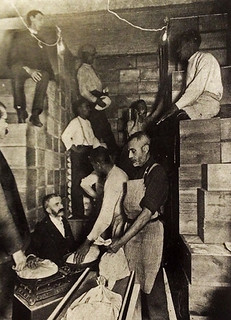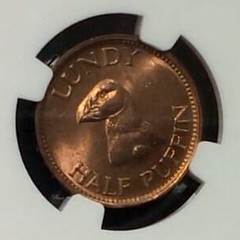
PREV ARTICLE
NEXT ARTICLE
FULL ISSUE
PREV FULL ISSUE
NOTES FROM E-SYLUM READERS: FEBRUARY 26, 2017 Ordering Lunch at the Old Treasury Vault I thank you, once again, for an informative and thought provoking weekly numismatic update. The item that attracted my attention was the second photograph in the Old U.S. Treasury Vault article. Is the gentleman standing right at the back using a mobile phone?
I think he's ordering pizza for the gang's lunch ...
-Editor
To read the earlier E-Sylum article, see:
More On One-Cent Checks When I moved from Chicago to Dallas in 1980, Illinois Bell Telephone sent me a one cent check that has been on the wall of my office ever since. And I stayed at the Sheraton in Mexico City many years ago and complained about the telephone charges that were charged. They sent me a check for 50 cents (25 cents a day) for my stay there and that check is also framed with the above one cent check. Another reader writes: I used to write one-cent checks as payment for credit card accounts. These were additional payments, after I had already made a payment in the minimum amount (or more). Reason I did this was twofold: 1) as a protest against the bank's high interest charges, by adding to their expense by making them process a check for one cent (and yes, they DID process them!). 2) This was back when the banks actually returned cancelled checks, so I figured/fantasized that if I ever got famous I'd have additional signed checks that I could sell to fans and collectors. Hey, a guy can dream, right?
Thanks, folks. In another souvenir from the era when banks returned cancelled checks, I was delighted to notice how artist J.S.G. Boggs had endorsed two checks I'd given him. In the rectangle reserved for a signature on the back of each check, he'd made a colorful drawing. Putting the two checks together the complete image of a motorcycle was revealed. I still have them.
-Editor
To read the earlier E-Sylum article, see:
More on Withdrawn Coins Last minted in 1956 the farthing was not demonetised until 31 December 1960, when they ceased to be legal tender. Decimal Day was 15 February 1971 but many coins were not withdrawn for years. Sixpences were last minted in 1967 but were not withdrawn until 30 June 1980. These coins were favourites with the public and there was a strong attachment to them. I suspect there will be a similar reluctance to withdraw the penny if that happens.
Thanks. Old habits die hard. When people are used to using certain coins from childhood it's tough to let go.
-Editor
To read the earlier E-Sylum article, see:
Bear Island, Norway

Dave Ellison writes: Bear Island is the southernmost island of the Norwegian Svalbard archipelago. The island is located in the western part of the Barents Sea, approximately halfway between Spitzbergen and North Cape, Norway. The whole island was privately owned by the coal mining company Bjornoen AS from 1918 to 1932, when the Norwegian state took over the shares. The note dates from this period of economic activity.
Ron Haller-Williams provided some Wikipedia links.
Thanks, everyone.
-Editor
Bear Island (Norway) (https://en.wikipedia.org/wiki/Bear_Island_(Norway)) Bjørnøen (https://en.wikipedia.org/wiki/Bj%C3%B8rn%C3%B8en)
To read the earlier E-Sylum article, see:
More On Grading Paper Money I enjoyed and can relate to David Gladfelter’s comments on grading paper money. However, I can also empathize with the grading services a bit. All grading is subjective so I would say to look at the item in the holder and not the grade on it when making a purchase decision. With that in mind, the more similar items you have graded the more consistency can be achieved in grading standards. Today billions of coins are being pumped out by the various mints. The biggest problem with these might be the tug between technical and market grading. Going back in time there were fewer coins produced that have survived and many different techniques used to produce them so more flexibility in what is graded for those coins would be expected. Similar points could be made for paper money, however, paper money is a relative new comer, both to the world and to grading so there may be a learning curve here. Surviving U. S. paper money and documents from prior to and even during the Civil War could be far fewer than similar coin items and even if they survive they are more fragile. Survivability of paper money is also impacted by the fact that there is no underlining silver or gold value once the paper money is no longer honored. The result is that there are more problems (stains, pin holes, corner clips, uneven cuts, etc.) with generally limited surviving paper money and documents. This fragility has led some collectors and the grading services to encapsulate items that might not otherwise be encapsulated and graded. I have seen several items encapsulated by PCGS without grades presumably to protect them. There is also another factor at play here, knowledge. There is a large amount of literature available on coins from ancient times to today. Thus expertise can and is developed quicker and easier for the coin collectors and graders than for paper money collectors and graders. Finding literature on many paper money series is relatively hard and expensive. Only in this century has the literature gap begun to be addressed. Newman issued his “vastly improved” (his opinion) fifth edition of The Early Paper Money in America in 2008. Whitman has started to update Haxby’s four volume set of Standard Catalog of United States Obsolete Bank Notes 1782-1866 (1988 – poor quality pictures) in 2014 with a projected 13(?) volume set (roughly $50-$60 a volume) of Whitman Encyclopedia of Obsolete Paper Money. These two cover continental & colonial and non-Federal obsolete bank issues only. There are a number of insurance, mining, railroad, turnpike, merchant and other issues and lots of local scrip issues not covered by these references. This means you have to hunt for almost always out-of-print limited editions for a specify area or series, if there is something written on them. The Society of Paper Money Collectors has tried to address this by issuing a number of books on obsolete currencies by state but some need updating and others need to be issued. Presumably the grading services have extensive libraries to consult but graders need to learn and absorb this information before grading paper money. The graders always seem to be good at the grades, but not so much on the identification, variety and other factors. I suspect some are involved in OJT like we learned about some of the graders for medals. I have resubmitted and gotten corrections at no cost on paper money items I thought they have done a poor job with the identification/variety. Bottom line, I would rather see a questionable item encapsulated with the appropriate comments on the front or reverse, rather than have the item rejected.
Thanks. All excellent points. Keep on collecting, studying, researching and writing, everyone!
-Editor
To read the earlier E-Sylum article, see:
More on the Puffin Coinage of Lundy
(a) Harman was charged with contravening Section 5 of the Coinage Act of 1870, though this is briefly mentioned in the video, and the last few words of the Coin World headline hint at it: "(well, maybe not legally)". He appealed from the verdict of the Petty Sessions (i.e. Magistrates' Court), to the High Court of Justice, where he also lost and was fined £5, with fifteen guineas (£15 15s) costs. (b) There have been restrikes dated 1965 (by John Pinches), 1977 (by Coincraft?) and 2011. The 1929 originals have the edge inscription "LUNDY LIGHTS AND LEADS", while the others (and some patterns of 1929) have plain edges, except for a reeded edge on the 2011 6-puffin coin. By the way, you faithfully reproduce the CoinWorld typo: Harmon for Harman in "“Harmon ordered 50,000 ..." The video soundtrack states that the puffin was halfpenny sized and the half puffin was the size of a farthing – this is accurate only with reference to the pre-1860 copper coins. See https://en.wikipedia.org/wiki/Coins_of_Lundy https://www.coincraft.com/1977-jubilee-lundy-set twice shows the wrong original date (1928), and states that the 1965 sets were by the Franklin mint. It also states that the Coinage Act case went to the House of Lords – as does https://en.wikipedia.org/wiki/Martin_Coles_Harman Even without the legal hassle, Harman could not have made much from this enterprise (unless he envisaged selling some later, at a premium) - just £19 7s 6d on an outlay of £293 2s 6d, by my reckoning, for coins with a face value of £312 10s; that's ignoring postage, letters and presumably phone calls – plus the overheads of accounting for the things! I had thought (obviously wrongly) that the edge inscription was the only feature which differentiated the 1965 issues from the 1929 ones.
Thanks! Who knew there was so much to know? (Not me).
-Editor
To read the earlier E-Sylum article, see:

Wayne Homren, Editor The Numismatic Bibliomania Society is a non-profit organization promoting numismatic literature. See our web site at coinbooks.org. To submit items for publication in The E-Sylum, write to the Editor at this address: whomren@gmail.com To subscribe go to: https://my.binhost.com/lists/listinfo/esylum All Rights Reserved. NBS Home Page Contact the NBS webmaster 
|

